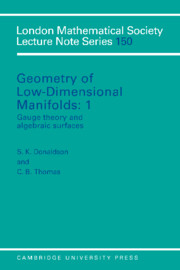Book contents
- Frontmatter
- Contents
- Contributors
- Names of Participants
- Introduction
- Acknowledgments
- PART 1 FOUR-MANIFOLDS AND ALGEBRAIC SURFACES
- PART 2 FLOER'S INSTANTON HOMOLOGY GROUPS
- PART 3 DIFFERENTIAL GEOMETRY AND MATHEMATICAL PHYSICS
- 11 Skyrme fields and instantons
- 12 Representations of braid groups and operators coupled to monopoles
- 13 Extremal immersions and the extended frame bundle
- 14 Minimal surfaces in quaternionic symmetric spaces
- 15 Three-dimensional Einstein-Weyl geometry
16 - Harmonic Morphisms, conformal foliations and Seifert fibre spaces
Published online by Cambridge University Press: 16 February 2010
- Frontmatter
- Contents
- Contributors
- Names of Participants
- Introduction
- Acknowledgments
- PART 1 FOUR-MANIFOLDS AND ALGEBRAIC SURFACES
- PART 2 FLOER'S INSTANTON HOMOLOGY GROUPS
- PART 3 DIFFERENTIAL GEOMETRY AND MATHEMATICAL PHYSICS
- 11 Skyrme fields and instantons
- 12 Representations of braid groups and operators coupled to monopoles
- 13 Extremal immersions and the extended frame bundle
- 14 Minimal surfaces in quaternionic symmetric spaces
- 15 Three-dimensional Einstein-Weyl geometry
Summary
INTRODUCTION
A harmonic morphism is a mapping between Riemannian manifolds which preserves Laplace's equation in the sense that it pulls back harmonic functions on the codomain to harmonic functions on the domain (see below). The aim of this paper is to introduce harmonic morphisms to the non-specialist and show how they occur naturally in low dimensional geometry. In particular, we shall show that each of Thurston's geometries apart from Sol has a natural map which can be characterized as the unique non-constant harmonic morphism to a surface (§3), and in §4, we shall show that, for any closed Seifert fibre space M3, there is a harmonic morphism with fibres equal to the fibres of M3. Finally, in §5 we use these ideas to give a simple explanation of why the product of a circle and a closed oriented Seifert fibre space with oriented fibres is naturally an elliptic surface.
The author wishes to thank several participants at the conference for useful conversations about this work, especially K.P. Tod, J.H. Rubinstein and J.D.S. Jones. Most of the work in this paper represents work of the author with Paul Baird. it is hoped that this informal account will prove useful for those wishing to taste the flavour of the subject but unable to read the full account in (Baird & Wood, 1988, 1989a, 1989b).
DEFINITIONS AND BASIC PROPERTIES
Harmonic morphisms
Let Mm and Nn be C∞ Riemannian manifolds of dimensions m and n respectively, and let ϕ:Mm → Nn be a CO mapping.
- Type
- Chapter
- Information
- Geometry of Low-Dimensional Manifolds , pp. 247 - 259Publisher: Cambridge University PressPrint publication year: 1991



